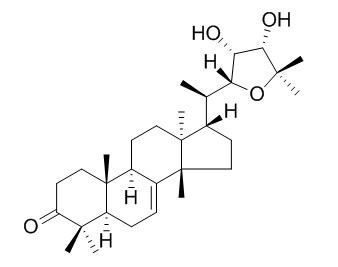Odoratone
Odoratone shows insecticidal activities, it shows mortality on fourth instar larvae of mosquitoes (Anopheles stephensi) with LC(50) values of 154 ppm. Odoratone exhibits strong antifeedant activity against Pieris brassicae.
Inquire / Order:
manager@chemfaces.com
Technical Inquiries:
service@chemfaces.com
Tel:
+86-27-84237783
Fax:
+86-27-84254680
Address:
1 Building, No. 83, CheCheng Rd., Wuhan Economic and Technological Development Zone, Wuhan, Hubei 430056, PRC
Providing storage is as stated on the product vial and the vial is kept tightly sealed, the product can be stored for up to
24 months(2-8C).
Wherever possible, you should prepare and use solutions on the same day. However, if you need to make up stock solutions in advance, we recommend that you store the solution as aliquots in tightly sealed vials at -20C. Generally, these will be useable for up to two weeks. Before use, and prior to opening the vial we recommend that you allow your product to equilibrate to room temperature for at least 1 hour.
Need more advice on solubility, usage and handling? Please email to: service@chemfaces.com
The packaging of the product may have turned upside down during transportation, resulting in the natural compounds adhering to the neck or cap of the vial. take the vial out of its packaging and gently shake to let the compounds fall to the bottom of the vial. for liquid products, centrifuge at 200-500 RPM to gather the liquid at the bottom of the vial. try to avoid loss or contamination during handling.
J Appl Biol Chem.2022, 65(4):pp.463-469.
Ind Crops Prod.2014, 62:173-178
Natural Product Communications2020, doi: 10.1177.
J Nat Prod.2022, doi: 10.1021
Journal of Food Composition and Analysis2021, 100:103905.
Tissue Cell.2022, 75:101728.
Processes2023, 11(2), 385¡£
Histol Histopathol.2022, 18518.
J Appl Biol Chem.2024, 67:33,238-244
J Funct Foods2019, 54:449-456
Related and Featured Products
Phytochemistry Review,2009, 8(3):601-620.
Azadirachta indica (neem): a plant of multiple biological and pharmacological activities[Reference:
WebLink]
Azadirachta indica, commonly called neem or ‘dogonyaro’ in Nigeria, is a plant that has found varied use in ecological, medicinal and agricultural sectors.
METHODS AND RESULTS:
Biological and pharmacological activities attributed to different parts and extracts of these plants include antiplasmodial, antitrypanosomal, antioxidant, anticancer, antibacterial, antiviral, larvicidal and fungicidal activities. Others include antiulcer, spermicidal, anthelminthic, antidiabetic, anti-implantation, immunomodulating, molluscicidal, nematicidal, immunocontraceptive, insecticidal, antifeedant and insect repellant effects. But toxicological activities such as allergic, genotoxic, cytogenetic and radiosensitizing effects have also been reported in humans and some economic animals, particularly, aquatic organisms, chicks and goats. Bioassay-guided studies and phytochemical analyses utilizing modern state-of-the-art techniques such as HPLC–MS, GC–MS, NMR and Infra Red spectroscopy have revealed that phytocompounds like azadirachtins, nimocinol, isomeldenin, azadirachtol (a tetranortriterpernoid), 2,3′-dehydrosalanol gedunin, nimbin, nimolicinol, Odoratone, azadironolide, isoazadironolide, naheedin and mahmoodin are responsible for the varied biological, pharmacological and toxicological properties observed.
CONCLUSIONS:
In this paper, we review how a developing country like Nigeria can harness the numerous opportunities presented by the multi-biological and multi-pharmacological nature of A. indica to solve some of her myriad problems, including those in the agricultural, health and economic sectors.
Chem Pharm Bull (Tokyo). 2003 Apr;51(4):415-7.
Tetracyclic triterpenoids from the leaves of Azadirachta indica and their insecticidal activities.[Pubmed:
12672995]
METHODS AND RESULTS:
A new tetranortriterpenoid, meliatetraolenone [24,25,26,27-tetranor-apotirucalla-(apoeupha)-6alpha-O-methyl, 7alpha-senecioyl(7-deacetyl)-11alpha,12alpha,21,23-tetrahydroxy-21,23-epoxy-2,14,20(22)-trien-1,16-dione] (1) was isolated from the methanolic extract of fresh leaves of Azadirachta indica along with the known compound Odoratone (3) which was hitherto unreported from this source. Their structures have been elucidated by spectral studies including 2D NMR.
CONCLUSIONS:
The insecticidal activities of 1 as well as those of Odoratone (3) are reported. 1 and Odoratone both showed mortality on fourth instar larvae of mosquitoes (Anopheles stephensi) with LC(50) values of 16 and 154 ppm, respectively.
Acta Botan. Sin., 2003, 45(9):1129-33.
A Novel Flavane from Carapa guianensis.[Reference:
WebLink]
METHODS AND RESULTS:
Seven compounds were isolated from the EtOH extraction of the twig of Carapa guianensis Aubl. (Meliaceae). On the basis of spectroscopic methods, their structures were elucidated as (-)-epicatechin-3-O-(3" , 5"-di-O-methyl) gallate (1), (-)-catechin (2), sciadopitysin (3), cleomiscosin B (4), photogedunin (5), chisocheton compound F (6) and Odoratone (7), respectively.
CONCLUSIONS:
Among them compound 1 was a new flavane, compounds 2-7 were firstly obtained from this plant, and compound 5 was assigned the C-13-NMR data for the first time. Compound 7 exhibited strong antifeedant activity against Pieris brassicae, and compound 2 exhibited moderate activity, while the n-BuOH portion showed weak activity.
Fitoterapia,2000,71(6):668–672.
A new triterpenoid from Azadirachta indica[Reference:
WebLink]
METHODS AND RESULTS:
A new triterpenoid, 1α,7α-diacetoxyapotirucall-14-ene-3α,21,22,24,25-pentaol (1), and the two known compounds Odoratone (2) and 2β,3β,4β-trihydroxypregnan-16-one (3) were isolated from a methanolic extract of the seed kernels of Azadirachta indica. Their structures were elucidated on the basis of spectral methods.



